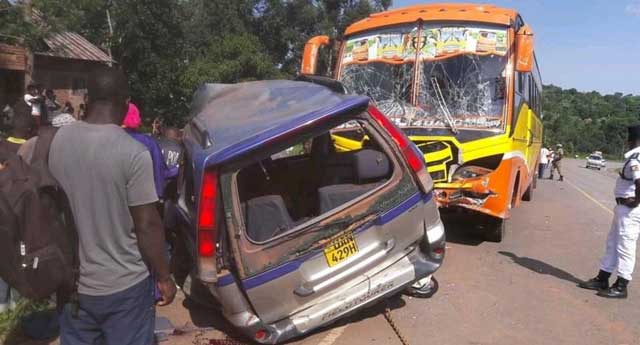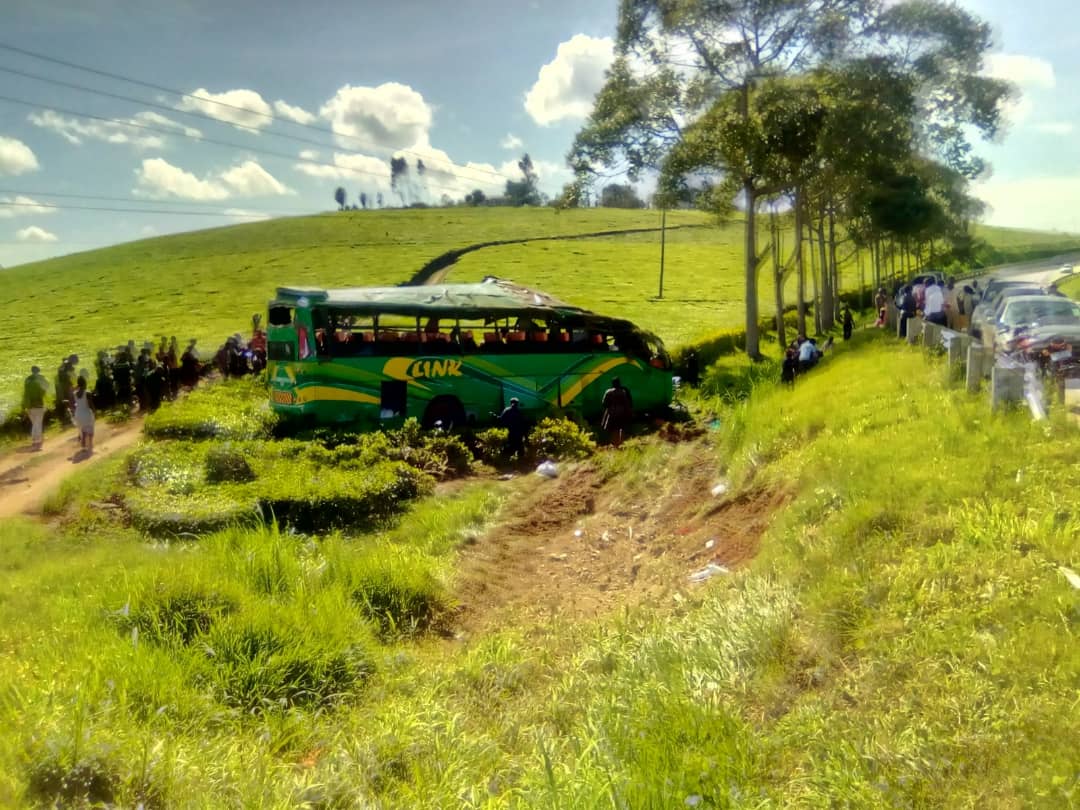The Uganda Government’s decision to ground 90 buses belonging to Link buses follows a series of road crashes in which the company buses have been involved since the start of 2022.
The freshest crash in the minds of many, if not all travellers, was last week on Wednesday morning May 4 2022. 20 passengers were confirmed dead at the scene after a Link bus overturned several times at Ssebitoli along Fort Portal-Kyenjojo road in western Uganda. Of the 20, according to the Traffic Directorate Spokesperson Faridah Nampiima, 13 were adults while seven were juveniles. 11 victims were male and nine were female.
A story recently published by this paper reported that preliminary findings suggested that the bus driver was speeding on a slope and lost control after overtaking a trailer at a high speed at a bend.
On the same day, six people were confirmed dead, and others seriously injured in a three-car crash along the Mbale-Tirinyi highway. The crash occurred at Mailo tano (Mailo five), approximately four Kilometers from Mbale City as a Kampala bound commuter taxi overtook another and ended up colliding with a Toyota Raum. Traffic police attributed the crash to reckless driving and failure to observe traffic guidelines.
The list of registered road crashes that have recently been registered is something of great concern. According to Uganda Police Force online portal, from February 28 2022 to March 6 2022, police registered 414 crashes. Of these, 75 accidents were fatal, 226 were serious and 113 were minor. There were 404 crash victims, out of which 89 people died and 315 sustained injuries.

The same portal says that from April 24 2022 to April 30 2022, police registered 387 crashes, out of which 60 were fatal, 213 were serious and 114 were minor. There were 341 crash victims, out of which 67 died and 274 sustained injuries.
A total of 119 crashes occurred on May 1 2022 and May 2 2022 and out of these, 21 crashes were fatal, 62 were serious and 36 were minor.
The portal adds that a total of 9,679 traffic offenders were arrested and issued Express Penalty Scheme tickets on various traffic offences at various checkpoints in the country from April 24 to May 2 2022. These included 1,709 for reckless driving, 2,089 for dangerous mechanical condition vehicles, 837 for invalid driving license, 446 for speeding, 760 not wearing seatbelts, 760 riding motorcycles without a crash helmet, 606 for carrying more than one passenger on the motorcycle and 144 others.
Road crashes are rarely caused by a single factor, but a combination of many. This makes road safety a shared responsibility. Speeding, which was the major cause of the Mbale-Tirinyi crash, is simply driving above the recommended speed at both built up areas and highways.
Jemima Nalumansi, the Initiative Coordinator, Kampala at the Bloomberg Philanthropies Initiative for Global Road Safety (BIGRS) says increased speed leads to reduced reaction time and longer distance covered and reduced opportunity to avoid a road crash.
“When speeding, there will be less or no time to notice and react to potential hazards. There will be loss of friction between tyres and the road but also loss of stability when negotiating bends and braking. It will also cause other road users to misjudge gaps,” Nalumansi explains.
A June 21 2021 World Health Organisation (WHO) fact sheet on road traffic injuries says an increase in average speed is directly related both to the likelihood of a crash occurring and to the severity of the consequences of the crash.
“Every one percent increase in mean speed produces a four percent increase in the fatal crash risk and a three percent increase in the serious crash risk. The death risk for pedestrians hit by car fronts rises rapidly to 4.5 times from 50km/h to 65km/h. In car to car side impacts, the fatality risk for car occupants is 85 percent at 65km/h,” the fact sheet partly reads.
Speeding in most cases leads to the sustenance of minor and major injuries, and at worst, deaths. When you knock a pedestrian, your driving speed will be too great for their body to contain and the chances of them dying are very high. Vehicle occupants especially those not wearing seatbelts, or those in a car without reliable safety features will hit the interior of the vehicle at a speed too great for the body to contain. When not wearing a seatbelt, the speed at which you drive will be the same speed at which your body will be ejected from the car through the windscreen in case of a head-on collision.
Other risk factors
Nampiima notes that human error accounts for the biggest percentage of road crash risk factors. This includes disrespect for road signage, drink-driving, phone or distracted driving, driving dangerous mechanical condition vehicles (DMCs), driving when fatigued, reckless driving and incompetent drivers who didn’t go to driving school to learn theory and practical lessons and acquired driving licenses through unjustified means.
“Some of you drive when fatigued. If you feel sleepy, park the car at a safe place by the roadside and rest or have enough rest before starting the journey. No energy drink stops you from sleeping because it (sleeping) is nature and you’ll doze off on the steering wheel and cause a crash,” Nampiima advises.
Road sign theft
Road signs communicate to motorists about proper road usage. Unfortunately, increased theft of these signs has also propelled road crashes. This makes it hard for motorists driving along certain roads for the first time to identify sections that have, for example, road humps or sharp corners to reduce speed.
According to section 48 of the Uganda National Roads Authority (UNRA) Regulations 2017, once found guilty of stealing road signs, when arraigned before court, you will either be imprisoned for two to seven years or pay a fine between 200-400 currency points, which is approximately Shs4m to Shs7m or serve both punishments, on top of reinstating of stolen signposts.
Driving dangerous mechanical condition vehicles
Dangerous mechanical condition (DMCs) vehicles, Nampiima explains, exist in many forms. These include vehicles that run out of fuel and park in the middle of the road or roadside, those with defunct indicators, brake and headlights, treadles tyres and worn-out wipers that cannot clear the windscreen when it’s raining, among others.
“If your vehicle has treadles tyres, it means you’ll skid off the road as you attempt to brake. Slow down when rain finds you on the road because it does not only affect visibility but it also increases your risk of veering off the road. The care you give to your car determines how safely it will take you,” Nampiima advises.
Road design
Norman Byamukama, a Road Safety Engineer at UNRA says road curves are designed to be negotiated at certain speeds and that each road has its prescribed design speed. If you negotiate a corner above the prescribed speed, which is always marked on a road sign, for instance at 65km/h, you risk causing a crash.
“Some road sections have metallic guardrails. If you make a mistake, your vehicle is protected from overturning. However, these guardrails are sometimes knocked. This means that you were driving above the design speed. Beyond a certain speed, the guardrails will not protect you,” Byamukama cautions.
Road width
Some crashes are blamed on the size of the road. However, Byamukama clarifies that the standard road width is based on the design class of the road. For instance, the width of national roads that connect districts and international borders is 3.5meters for the outgoing and oncoming lanes while there are some that measure three meters on either lane.
Other factors include natural ones such as rain and fog or any others that affect proper road visibility.
Possible solutions
Nampiima suggests that a system electronically monitored by traffic police, the Ministry of Works and Transport and Uganda Driving License Systems (UDLS) be put in place to monitor whoever qualifies to operate a vehicle on the road.
“Immediately you join the driving school, all agencies will be aware of when you joined. After leaving driving school with a certificate to be tested at the inspectorate of vehicles, the system is able to capture the days you spent learning to drive. This qualifies you for a professional driving license at UDLS. This will eliminate the challenge of incompetent drivers as causes of crashes on the road,” Nampiima opines.
“There should be constantly intensified traffic police operations as opposed to those that are seasonal. Whoever is got on the wrong side of the law should be apprehended and it should be an element of police and court. If someone is arraigned before court for being a habitual traffic offender, the court should cancel their driving license. It will create discipline in motorists instead of cautioning them. What happens is that before a traffic officer handles the offender, they are called to release the car on top of being threatened. Politics or any other powers of influence should get out of road safety issues. When you commit an offence on the road, you are fighting and are capable of ending a life,” Nampiima adds.
Swift emergency response
There should also be a standard emergency response unit to road crashes, with at least two ambulances on every major highway. What causes victim deaths is not crashes, but sustained injuries. Some victims at the scene are in shock and coma, but not dead and just need attention for their lives to be saved.
Previous statistics
The 2020 Police Annual Crime report says a number of 3,269 fatal crashes were registered while 3,407 fatal crashes were registered in 2019. The same report says a total of 5,803 serious or major crashes were registered while 5,992 major crashes were registered in 2019. Minor crashes registered in 2020, the report adds, were 3,177 and 3,459 in 2019.
The month of December, the report says, had the highest number of crashes with 1,445 crashes followed by October with 1,328 crashes and September with 1,270 crashes, among others. April registered the lowest number of crashes with 470 crashes, followed by May with 631 crashes due to the total lockdown of the country and restricted movement of vehicles during this period.
Written by Roland Nasasira for The Daily Monitor. Roland is also a member of the Land Rover Uganda Club and Media Coordinator for Towards Zero East Africa.
Link to original article: https://www.monitor.co.ug/uganda/business/auto/what-causes-a-road-crash–3813224
Share this article
Written by : Derrick Nasasira
Roland D Nasasira is Road Safety Journalist and All-around Features Writer @DailyMonitor, Car enthusiast and Traveller. He is also a member of the Land Rover Uganda Club.





